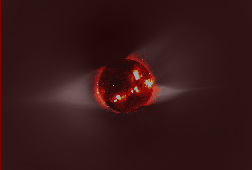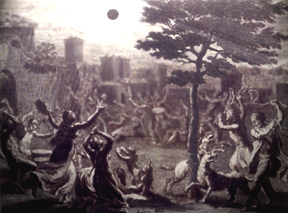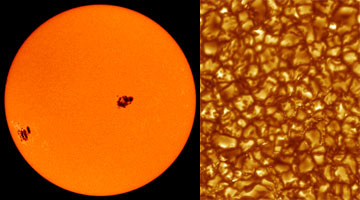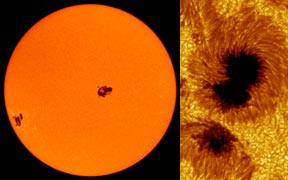These two large prominences (lower right and lower left) erupted from the Sun in March 2003. This ultraviolet image was captured by the SOHO spacecraft.
Click on image for full size
Image courtesy SOHO (NASA & ESA).
Solar Prominence
Text for this level has not been written yet.
Please see the "Intermediate" text for this page if you want to
learn about this topic.
To get to the "Intermediate" text, click on the blue "Intermediate" button
at the top of the page (between the "Beginner" and "Advanced" buttons).
You might also be interested in:

Rising above the Sun's chromosphere , the temperature jumps sharply from a few tens of thousands of kelvins to as much as a few million kelvins in the Sun's outer atmosphere, the solar corona. Understanding
...more
Solar eclipses are really great to watch! But in the past, people were very scared of them. They didn't understand what was going on. Some people thought that a monster or animal was eating the Sun! They
...more
Most of the energy we receive from the Sun is the visible (white) light emitted from the photosphere. The photosphere is one of the coolest regions of the Sun (6000 K), so only a small fraction (0.1%)
...more
An eclipse of the Sun occurs when the Earth passes through the moon's shadow. A total eclipse of the Sun takes place when the Moon is directly between the Sun and the Earth. When a total eclipse does
...more
The gas in the solar corona is at very high temperatures (typically 1-2 million kelvins in most regions) so it is almost completely in a plasma state (made up of charged particles, mostly protons and electrons).
...more
Sunspots are dark spots on the Sun. They may look small, but they are actually as bigas a planet like Earth or Mars! Sunspots are "dark" because they are colder than the areas around them. Of course, they
...more
Text for this level has not been written yet. Please see the "Intermediate" text for this page if you want to learn about this topic. To get to the "Intermediate" text, click on the blue "Intermediate"
...more














